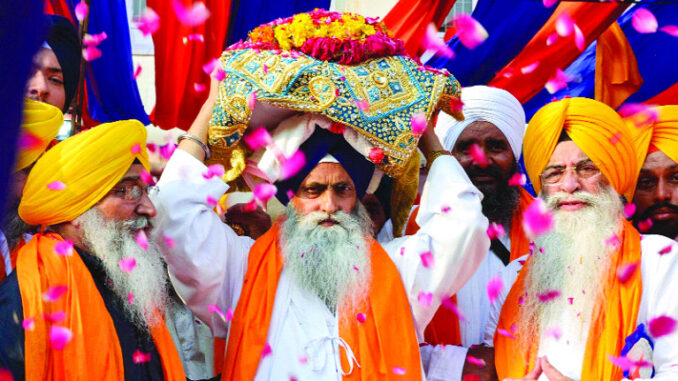
Sikhs believe in one God. He is the same for all people of all religions. Sikhism teaches equality of all people. Sikhism preaches that people of different races, religions, or sex are all equal in the eyes of God. Sikhism teaches the full equality of men and women.
Sikhism emphasizes daily devotion to the remembrance of God. One should remember God at all times.
Sikhism teaches religious freedom. All people have the right to follow their own path to God without condemnation or coercion from others.
Sikhism emphasizes a moral and ethical life. A Sikh should represent moral responsibility and righteousness.
Sikhism rejects all forms of rituals such as idol worship, pilgrimages, fasting, and superstitions.
Sikhism teaches service to others. The primary task in life should be to help the poor, needy, and oppressed. The Sikhs have a long heritage of speaking out against injustice and for standing up for the defenseless.
Sikhs are supposed to be saints, scholars, and soldiers.
The word Sikh means disciple or student. Sikhs are the disciples of God who follow the writings and teachings of the ten Sikh Gurus.
Three Principles of Sikhism
– Kirat Karo – Work hard and honestly
– Wand Ke Chhako – Share what you have with the needy
– Naam Jappo – Always remember God throughout the day
Facts about Sikhism
– Sikhism is the fifth largest religion in the world.
– It is a distinct religion with its own unique, divine scriptures and beliefs.
– The Sikh religion originated in the Punjab region of India in the 15th century by Guru Nanak Dev.
– Sikhism is a monotheistic religion.
– Sikhism advocates equality for men and women of every race and religion.
– Many Sikhs throughout history are respected for having sacrificed their own lives, so that people of other religions may have freedom to worship in the manner of their choice.
– There are over 30 million Sikhs worldwide.
– Sikhs live in just about every major country around the world.
– The vast majority of Sikhs live in the Punjab, a part of northern India.
– There are over one million Sikhs in the United States and Canada. Sikhs have lived in North America for over 100 years.
– About a half million Sikhs are estimated to live in the United Kingdom.
– The first Sikh migration to the United Kingdom was in the 1950s.
Faith
– Sikh men and women cover their heads at all times as an expression of respect to their Gurus.
– The Sikh turban symbolizes discipline, integrity, humility, and spirituality. The turban is a mandatory part of Sikh faith, not a social custom, or a hat that can be easily taken on or off.
– The universal symbol of Sikhism is the khanda, the double-edged sword flanked by two daggers (representing worldly and spiritual powers, bound by the oneness of God).
– The traditional greeting used by Sikhs is “Waheguru ji ka Khalsa, Waheguru ji ki Fateh” which means “The Khalsa belongs to God, Victory belongs to God”. Another traditional greeting is “Sat Sri Akal” which means “Immortal God is Truth”.
Five Sikh Symbols
The Five Ks are the five items of dress and physical appearance given to Sikhs by Guru Gobind Singh when he gathered together the first members of the Khalsa on Vaisakhi day in 1699. These symbols give Sikhs a unique identity signifying discipline and spirituality. However, these items cannot be reduced to just symbols and must be worn in their full form.
Kesh
– Uncut hair, which is kept covered by a turban, or dastaar.
– Kesh are a traditional symbol of holiness in India, and the turban is a symbol of leadership.
– The dastaar is worn by men and some women to cover their long hair.
Kirpan
– A ceremonial sword, symbolizing readiness to protect the weak, and defend against injustice and persecution.
– The kirpan is normally worn with a cloth shoulder strap called a gatra.
– The kirpan exemplifies the warrior character of a Sikh.
Kara
– A steel bracelet, symbolizing strength and integrity.
– Steel is symbolic of strength yet resilient under stress. In the same way, the human soul must become as strong and unbreakable as steel which has been tempered in the furnace.
Kangha
– A small wooden comb, symbolizing cleanliness and order.
– The kangha is used to keep the hair clean and is normally tucked neatly in one’s uncut hair.
– As a Sikh combs their hair daily, he or she should also comb their mind with the Guru’s wisdom.
Kachhera
– Cotton boxer shorts, symbolizing self-control and chastity; prohibition of adultery.
The Oneness of God
Like the people of ancient times, the common people of Guru Nanak’s day paid tribute to a large number of minor gods and goddesses which were then known to Hinduism. They were attached to these in superstitious bondage and fear evolved over the centuries, and which had no relation at all to religion as such. Instead of deriving comfort, therefore, such adherents suffered more from fear and worry. Superstitious ceremonies were encouraged by Brahmin priests and astrologers who made handsome profits out of the gullibility of the people. It was to exterminate these practices and to counteract these evil influences that Guru Nanak emphasized strict monotheism in his teachings. He, therefore, composed the Mool Mantra and taught it to all his followers:
There is one God
His Name is Truth
The All-pervading Creator,
Without fear, without hatred
Immortal, unborn, self-existent,
By grace, the Enlightener.
True in the beginning, true throughout the ages,
True even now, Nanak, and forever shall be true. (Japji, Mool Mantra)
His devoted follower, Lehna, who was destined to become the second Guru, took this verse seriously to heart. Lehna, on becoming Guru Angad, propagated this thesis, and said that it was intended to be learned and understood and repeated by all Sikhs in order to remind them of God’s One-ness and of His other most important attributes. God is Everything to the Sikh: His attributes are endless and all goodness, mercy and love are contained in Him. He has created all things and remains enshrined within them as both mind and matter. He is immanent. He is also transcendent; for He can and does exist without creation, above and beyond everything. He is All-powerful; nothing exists or happens without His knowledge or without His permission; He sees into all things and directs even the smallest affairs of His creatures. God is the Divine Father who cares for His children, bestows upon them all the manifold blessings of this world and listens to their prayers. He knows the most secret desires of every heart and is the essence of love and forgiveness. God is directly accessible to everybody and man’s soul itself is a part of the Immortal One.
Service
The way to salvation is a twofold path: the path of love or simran, and the path of seva, or service to mankind. Love means little until it is exposed in action, so the Sikh cannot rightly remain inactive, but of necessity, he must engage himself in the affairs of the world, while also following the path of earnest meditation. He is expected to seize every opportunity of helping his fellow-beings and of serving them in any way he can, without expecting rewards. To do this, therefore, he must have no selfish desires; his mind must be free of greed and attachment to power or riches, and he must have a truly humble heart.
Brotherhood
“The Fatherland of God and the brotherhood of man” is one of the main themes of Guru Nanak’s message. All are welcomed into the fold of Sikhism without regard of caste, class, color, race, sex, or creed; all are treated on equal terms. Nobody is, therefore, favored simply because of superior birth or secular influence. One of the main complaints of the Hindus against Guru Gobind Singh, the Tenth Guru, was that by creating the Khalsa, he was destroying the caste system. It is to be remembered that since Guru Nanak’s day, it had been customary for all visitors to the Guru’s court to eat together at the communal free kitchen (langar) provided; and it was the Guru’s rule that no one be looked down upon or refused. There is no priestly class or religious hierarchy amongst the Sikhs, and any Sikh man or woman may take part in the religious ceremonies, as well as officiate at these. These principles Guru Gobind Singh maintained.
Humility
No man can inspire to reach God if his own heart is full of pride and egotism. Man must always beware of the pitfalls of assumed or false humility. Even deliberate self-abasement can be a form of pride, since it arises out of egotism and self-esteem. True humility lies in being aware of one’s own abilities and shortcomings; it lies in the knowledge that God alone is the Doer of all actions; He alone is the Giver of all gifts; it is only by His favor that we enjoy riches, honor and achievement in this world.





Be the first to comment